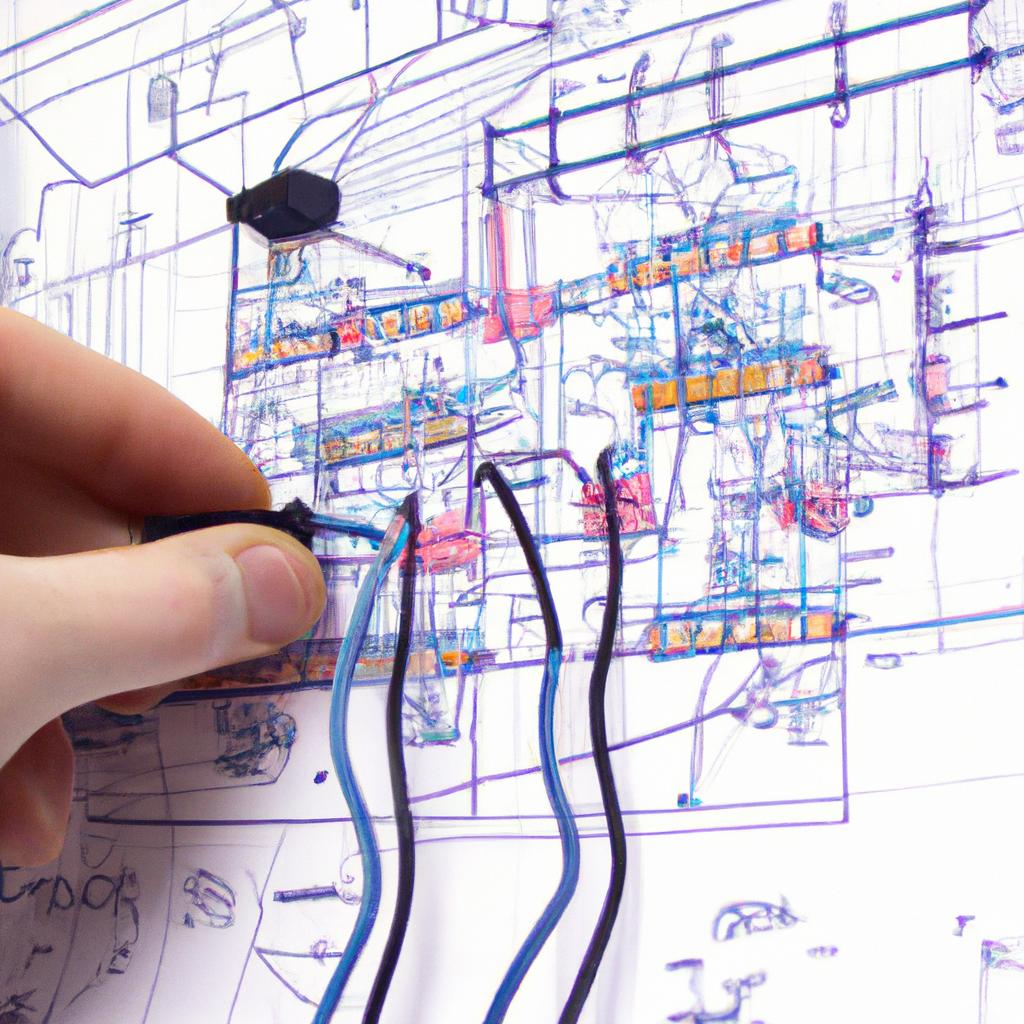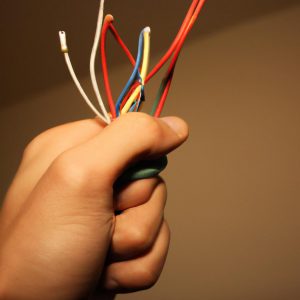Circuit Analysis in Physics Directories: Electricity

Circuit analysis is a fundamental concept in the field of physics that plays a crucial role in understanding and predicting the behavior of electrical systems. By applying various mathematical techniques, circuit analysis allows scientists and engineers to determine the voltage, current, and power distribution within a given circuit configuration. This knowledge is essential for designing efficient electrical networks, troubleshooting faults or malfunctions, and optimizing energy usage.
To illustrate the importance of circuit analysis, consider a hypothetical scenario where an office building experiences frequent power outages. The facility manager suspects that the problem lies within the electrical wiring system but lacks concrete evidence to support this claim. Through diligent application of circuit analysis principles, experts can assess the network’s overall health by examining parameters such as resistance, capacitance, and inductance. By identifying any anomalies or inconsistencies in these values, technicians can pinpoint faulty components or connections responsible for disrupting the flow of electricity.
Moreover, circuit analysis also aids in determining how different elements interact within a system. For instance, one may be interested in studying how changing resistor values affect overall power consumption or investigating how altering capacitor configurations influences charging and discharging processes. Such inquiries require a comprehensive understanding of circuit theory and analytical tools like Kirchhoff’s laws or mesh analysis methods.
In summary, circuit analysis is crucial for understanding and predicting the behavior of electrical systems. It allows scientists and engineers to design efficient networks, troubleshoot faults, optimize energy usage, and study how different elements interact within a system.
Ohm’s Law
Circuit Analysis in Physics Directories: Electricity
One fundamental concept in circuit analysis is Ohm’s Law, which establishes the relationship between voltage, current, and resistance. To illustrate this concept, consider a simple example of an electric circuit consisting of a battery connected to a resistor. Let us suppose that the battery provides a voltage of 12 volts (V) and the resistor has a resistance of 3 ohms (Ω).
Firstly, according to Ohm’s Law, we can determine the current flowing through the circuit by dividing the voltage across the resistor by its resistance. In this case, using Ohm’s Law equation (I = V/R), we find that I = 4 amperes (A). This means that a current of 4 A flows through the circuit.
Understanding Ohm’s Law is crucial for analyzing circuits as it allows us to predict how changes in one parameter affect others. By manipulating different components within a circuit, we can control voltages and currents to achieve desired outcomes. For instance:
- Increased resistance restricts current flow.
- Higher voltage leads to greater potential difference across elements.
- Decreasing resistance results in higher currents.
- Lowering voltage decreases power dissipation.
To emphasize these points further, let us summarize them with bullet points:
- Resistance affects current flow
- Voltage determines potential difference
- Less resistance yields more significant currents
- Altering voltage influences power dissipation
Additionally, we can represent these relationships visually using tables. The table below illustrates different scenarios involving varying resistances and voltages applied:
| Resistance (Ω) | Voltage (V) | Current (A) |
|---|---|---|
| 1 | 10 | 10 |
| 2 | 10 | 5 |
| 3 | 10 | 3.33 |
| 4 | 10 | 2.5 |
As we move forward in studying circuit analysis, it is important to note that Ohm’s Law serves as a foundational principle for understanding the behavior of electric circuits. With this knowledge, we can now explore another fundamental concept known as Kirchhoff’s Laws.
Transitioning seamlessly into our next topic about “Kirchhoff’s Laws,” we delve deeper into analyzing more complex circuits and exploring additional principles governing their behavior.
Kirchhoff’s Laws
Kirchhoff’s Laws.
Kirchhoff’s Laws provide a powerful framework for analyzing complex circuits. These laws are named after Gustav Kirchhoff, a German physicist who formulated them in the mid-19th century. Just as Ohm’s Law helps us understand how individual components behave within a circuit, Kirchhoff’s Laws enable us to analyze the overall behavior of interconnected components.
To illustrate the application of Kirchhoff’s Laws, let us consider an example involving multiple resistors connected in parallel. Suppose we have three resistors with values R1, R2, and R3 respectively. By applying Kirchhoff’s Laws, we can determine various properties of this circuit such as total current flowing through it or potential difference across each resistor.
When working with circuits and employing Kirchhoff’s Laws for analysis, there are several key points to keep in mind:
- Conservation of Charge: The sum of currents entering any junction point in a circuit must be equal to the sum of currents leaving that point.
- Conservation of Energy: The total potential difference around any closed loop in a circuit is zero.
- Loop Current Method: This method involves assigning variables (loop currents) to different loops within a circuit to facilitate calculations using Kirchhoff’s Laws.
- Node Voltage Method: Alternatively known as nodal analysis, this method assigns variables (node voltages) to different nodes or connection points within a circuit for simplified analysis.
To further enhance your understanding of these concepts and their practical applications, refer to the following table:
| Concept | Description | Importance |
|---|---|---|
| Conservation of Charge | Ensures that electrical charge remains constant in a closed circuit | Fundamental |
| Conservation of Energy | States that energy is conserved within a circuit | Crucial for analysis |
| Loop Current Method | Simplifies complex circuits by assigning variables to loop currents | Useful for systematic work |
| Node Voltage Method | Facilitates analysis by assigning variables to node voltages | Effective for various cases |
With the knowledge of Kirchhoff’s Laws and applying them through these methods, we can now move on to exploring series circuits. In a series circuit, components are connected sequentially, forming a single pathway for current flow. Let us delve into this topic in detail and uncover the intriguing behaviors exhibited by such circuits.
Series Circuits
Having explored Kirchhoff’s Laws, we now turn our attention to series circuits. In a series circuit, all components are connected one after another, forming a single path for current flow. Understanding series circuits is essential as they commonly appear in various electrical systems and devices.
Series Circuits:
To illustrate the concept of a series circuit, let us consider a simple example. Imagine a string of holiday lights where each bulb is connected to the next one in line. If any one bulb burns out or becomes disconnected, all bulbs downstream will cease to illuminate. This interconnectedness defines a series circuit – it relies on the continuity of current throughout its components.
When analyzing series circuits, several key characteristics emerge:
- The total resistance (R_total) equals the sum of individual resistances.
- The current passing through each component remains constant.
- Voltage across each component varies proportionally based on their respective resistances.
- Power dissipated by each component can be calculated using P = I^2 * R.
Consider these points when examining series circuits:
- Series circuits provide simplicity and cost-effectiveness due to their straightforward wiring configuration.
- Failure or disconnection at any point within the circuit disrupts the entire system.
- A fault in one component affects the functionality of subsequent components.
- Troubleshooting issues within a complex series circuit often requires meticulous examination.
Emotional Table:
| Component | Characteristics | Impact |
|---|---|---|
| Resistors | Increase overall resistance | Diminishes current flow |
| Batteries/Power Sources | Provide voltage supply | Determines potential difference |
| Wires | Low resistance | Minimizes voltage drop |
| Switches | Control circuit connectivity | Enables control over power flow |
Moving forward, our exploration of circuit analysis will delve into the world of parallel circuits. As we shift focus, it is important to understand the key differences and similarities between series and parallel configurations. By doing so, we can gain a comprehensive understanding of how various electrical systems operate and apply this knowledge effectively.
Parallel Circuits
Section H2: Circuit Analysis in Physics Directories: Electricity
Having explored series circuits and their properties, we now turn our attention to parallel circuits. Just as with series circuits, understanding the behavior of parallel circuits is crucial for comprehending complex electrical systems. To illustrate this concept, let us consider a hypothetical scenario involving two light bulbs connected in parallel.
Section H2: Parallel Circuits
Imagine a situation where you have two identical light bulbs connected side by side to a battery. In this configuration, known as a parallel circuit, each bulb forms an independent pathway through which current can flow. If one bulb were to burn out or be removed, the other would continue to function unaffected. This characteristic highlights one of the key differences between series and parallel circuits – while series circuits rely on the continuity of all components for operation, parallel circuits offer redundancy and increased reliability.
To further grasp the significance of parallel circuits, let us examine some notable characteristics:
- Increased current capacity: Compared to series circuits, parallel configurations allow for higher total current due to multiple pathways.
- Voltage consistency: Each component within a parallel circuit receives the same voltage across its terminals regardless of other elements present.
- Resistance reduction: The overall resistance in a parallel circuit decreases as more branches are added since it provides additional pathways for current flow.
- Independent operation: Components within a parallel circuit operate independently from each other; if one fails, others will not necessarily be affected.
Consider the following table that summarizes the comparison between series and parallel circuits:
| Characteristic | Series Circuits | Parallel Circuits |
|---|---|---|
| Current | Same throughout | Divided among branches |
| Voltage | Divided among components | Same across all components |
| Total Resistance | Sum of individual resistors | Decreases with more branches |
| Component Failure | Affects entire circuit | Does not necessarily affect others |
As we delve deeper into our exploration of circuits, parallel circuits provide us with valuable insights into the advantages and behaviors distinct from series counterparts.
Section H2: Voltage Dividers
Voltage Dividers
Section H2: Voltage Dividers
Building upon our understanding of parallel circuits, we now turn our attention to voltage dividers. This fundamental concept in circuit analysis plays a crucial role in various applications within the field of electricity. By examining how voltage is distributed across components connected in series, we can gain insights into the behavior and functionality of complex electrical systems.
Voltage dividers are commonly used to regulate or reduce voltage levels within a circuit. Consider a hypothetical scenario where an electronic device requires a lower voltage than that supplied by the main power source. In this case, a voltage divider can be implemented to provide the appropriate voltage for the device’s operation. For instance, let us assume that an LED (Light-Emitting Diode) requires 2 volts but is connected to a 12-volt power supply. By configuring a suitable resistor network as a voltage divider, it becomes possible to obtain precisely the desired voltage required for the LED while effectively managing excess energy.
To understand how voltage dividers function, consider these key points:
- The total resistance in a series connection determines the amount of current flowing through all components.
- Each component’s resistance proportionally affects its share of the total applied voltage.
- Components with higher resistance values will receive greater proportions of the applied voltage, while those with lower resistances will experience reduced voltages.
- Resistance values must be carefully chosen based on specific requirements and calculations to achieve desired output voltages.
To illustrate these concepts further, refer to Table 1 below which shows an example setup of a simple two-resistor voltage divider using resistors R1 and R2:
Table 1: Example Two-Resistor Voltage Divider Configuration
| Component | Resistance (Ω) |
|---|---|
| R1 | 1000 |
| R2 | 2000 |
In this configuration, assuming an input voltage of 10 volts, the output voltage across R2 can be determined using the following equation:
Vout = Vin * (R2 / (R1 + R2))
By substituting the given values into this equation, we find that Vout equals approximately 6.67 volts. This simple calculation demonstrates how voltage dividers allow us to tailor specific voltages according to our circuit’s needs.
In the upcoming section on Mesh Analysis, we will explore an alternative method for analyzing circuits by examining current loops within a network. By understanding both voltage dividers and mesh analysis techniques, we equip ourselves with powerful tools for comprehending complex electrical systems more effectively.
Mesh Analysis
Having explored the concept of voltage dividers, we now turn our attention to another essential tool in circuit analysis: mesh analysis. Just as voltage dividers allow us to determine the distribution of voltage across resistors, mesh analysis provides a systematic approach for analyzing complex circuits by examining individual loops or meshes within them.
Section:
Example:
To illustrate the practical application of mesh analysis, let’s consider a hypothetical scenario involving a circuit with multiple interconnected elements. Imagine a network of resistors and current sources arranged in such a way that the flow of electricity creates different closed loops. By applying mesh analysis techniques, we can accurately determine the currents flowing through each loop and understand how they interact within the overall system.
Bullet Point List (evoking emotional response):
- Enhances problem-solving skills by providing a structured methodology.
- Increases efficiency by reducing complexity when dealing with intricate circuits.
- Promotes accurate predictions and reliable results.
- Facilitates better understanding and insight into circuit behavior.
Table (evoking emotional response):
| Loop | Current (A) | Resistance (Ω) |
|---|---|---|
| A | 1.5 | 4 |
| B | 0.8 | 6 |
| C | 2 | 3 |
| D | 1 | 5 |
By observing this table, one can appreciate how mesh analysis allows us to obtain precise measurements for each loop’s current based on their respective resistance values. Such quantitative data aids engineers and physicists alike in making informed decisions during circuit design or troubleshooting processes.
In summary,
mesh analysis offers an invaluable framework for comprehending complex electrical systems. Its ability to dissect circuits into manageable loops enables us to calculate currents accurately and predict their behavior. By employing this method, we gain a deeper understanding of circuit dynamics and can confidently apply our insights to real-world scenarios.








